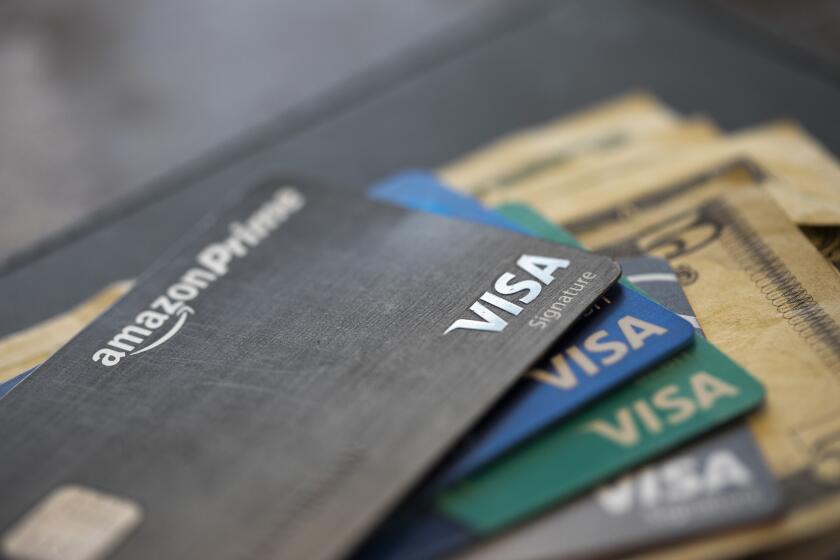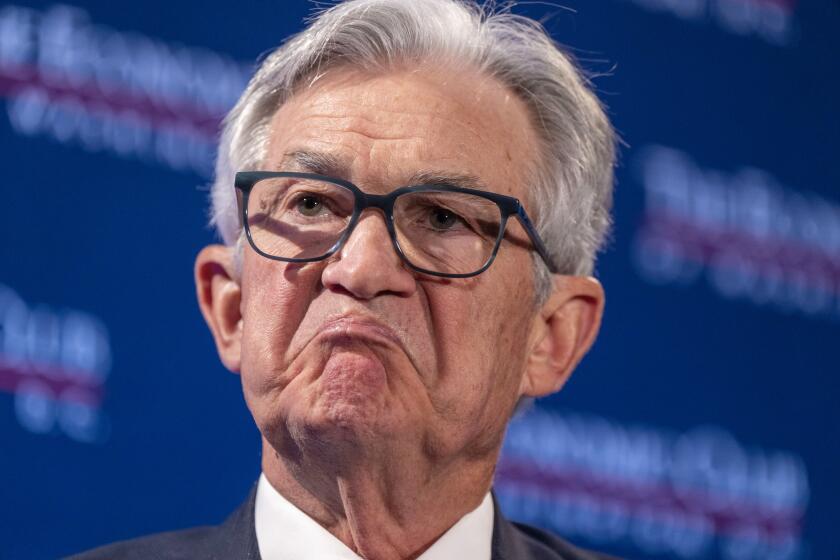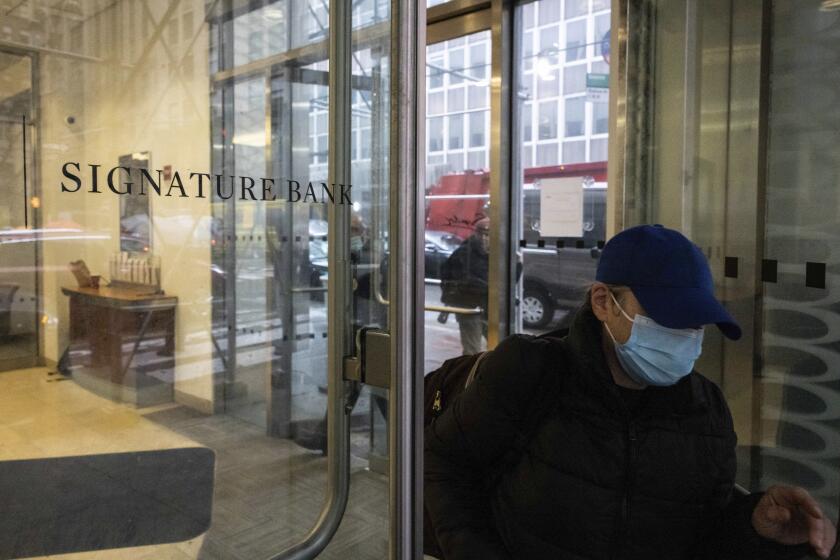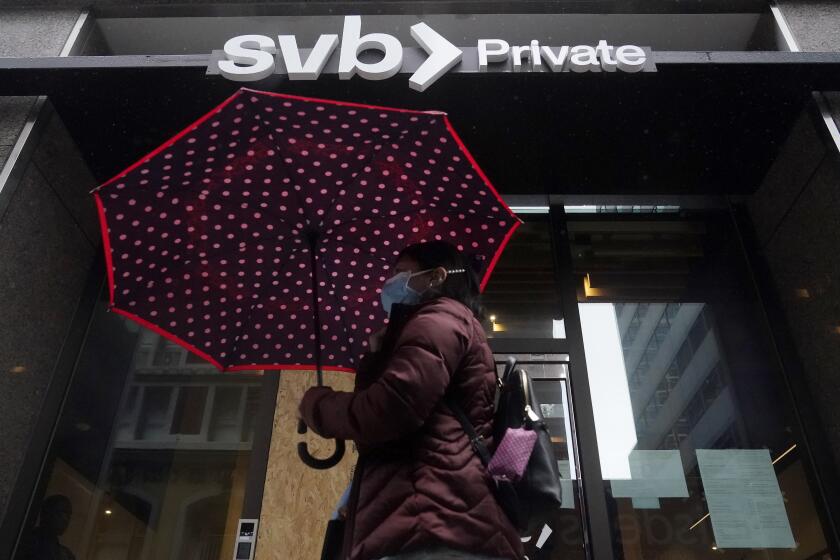Stocks rise on Wall Street after bank deal, regulator moves
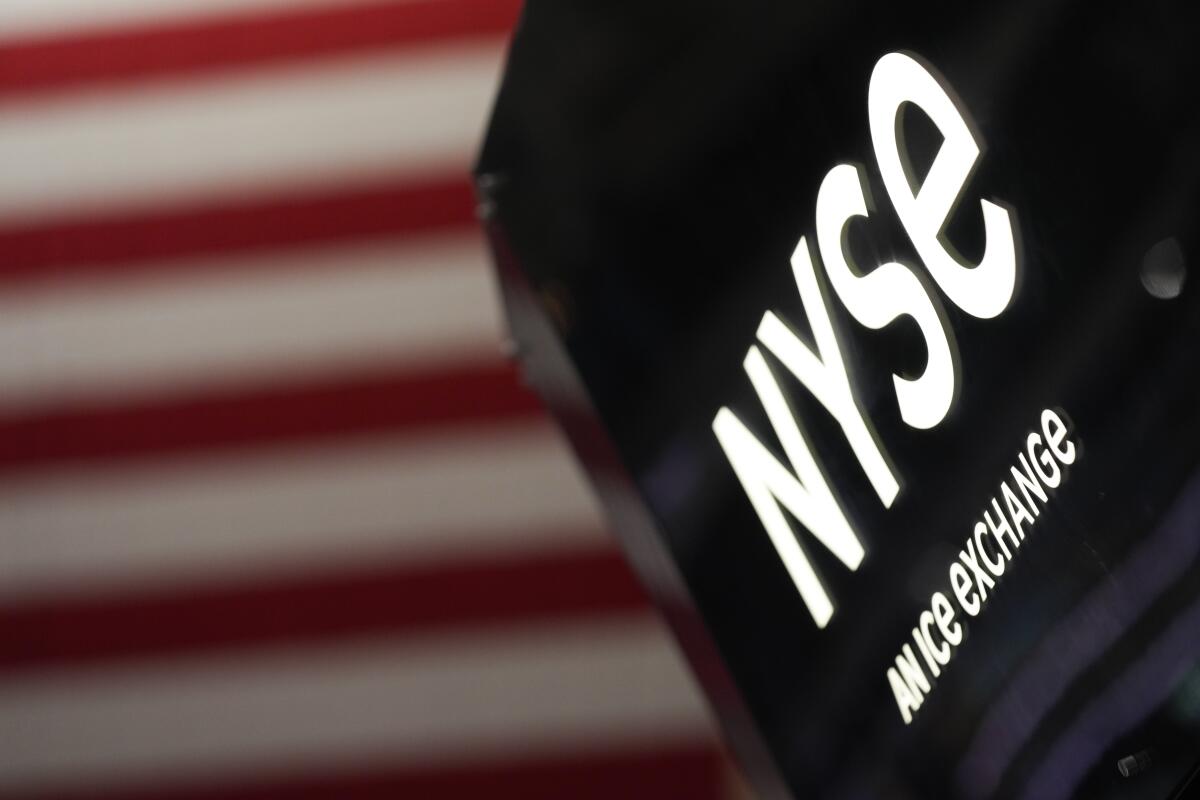
- Share via
Stocks rose on Wall Street on Monday after regulators pushed together two huge banks over the weekend and made other moves to build confidence in the struggling industry.
The Standard & Poor’s 500 index climbed 34.93 points, or 0.9%, to 3,951.57. The Dow Jones industrial average gained 382.60 points, or 1.2%, to close at 32,244.58. The Nasdaq composite rose 45.02 points, or 0.4%, to 11,675.54.
Much of the attention has been on banks because they may be cracking under the pressure of much higher interest rates. Swiss banking giant UBS said Sunday it would buy its rival Credit Suisse for almost $3.25 billion in a deal quickly put together by regulators. Credit Suisse has been battling a unique set of problems for years, but they came to a head last week as its stock price tumbled to a record low.
A group of central banks including those of the United States and Japan also announced coordinated moves Sunday meant to ease strains in the financial system. They should allow banks more access to U.S. dollars if needed, in an echo of a practice widely used in prior crises.
With conditions changing by the hour, traditional economic data points — typically released monthly or quarterly with a lag — prove less helpful. Here are some better ways to gauge economic health.
The moves don’t mean the banking industry’s crisis is over, but “it’s taken one of the troublesome aspects off the table,” said Ryan Detrick, chief market strategist at Carson Group.
The late Sunday announcements by regulators may be reminiscent of the 2007-08 financial crisis that wrecked the global economy, but many investors see big differences between then and now.
“The market is trying to digest: Is this just a few bad financial companies that have really made some bad decisions, or is the whole thing a house of cards?” Detrick said. “We’re optimistic that it’s multiple banks in a bad situation but not the entire system.”
In the U.S., most of the attention has been on smaller and midsize banks on fears that falling trust could push their depositors to pull their money all at once. That’s what’s called a bank run, and such a move could topple them.
First Republic Bank has been at the center of investors’ crosshairs in the hunt for the industry’s next victim after the second- and third-largest U.S. bank failures in history. Its shares fell 47.1% after S&P Global Ratings cut its credit rating for First Republic for a second time since Wednesday.
In the brief but spectacular collapse of Silicon Valley Bank, we may just have witnessed the best banking crisis ever. It might even have been useful.
S&P said it could lower the rating even further despite a group of the biggest U.S. banks announcing last week they would deposit $30 billion in a sign of faith in First Republic and the larger banking industry.
Although that money certainly helps, “it may not solve the substantial business, liquidity, funding and profitability challenges that we believe the bank is now likely facing,” the credit rating company said.
Stocks of other smaller and midsize banks, meanwhile, were much stronger.
New York Community Bancorp jumped 31.7% after it agreed to buy much of Signature Bank in a $2.7-billion deal, the Federal Deposit Insurance Corp. said late Sunday. Signature Bank became the industry’s third-largest failure this month after regulators seized it.
Much of the rest of the U.S. stock market also pushed higher, but how long that lasts is a question mark. A huge decision by the Federal Reserve is looming on the calendar.
With the recent failures of Silicon Valley Bank and Signature Bank, here are ways to make sure your money is safe.
The U.S. central bank will announce its latest move on interest rates Wednesday. For a while, the big bet on Wall Street was that it would reaccelerate its increases because of how stubborn high inflation has remained.
Higher rates can undercut inflation by slowing the economy, but they raise the risk of a recession. They also hurt prices for stocks, bonds and other investments. That was one of the factors hurting Silicon Valley Bank, which this month became the second-biggest U.S. bank failure in history. Bonds owned by it and other banks have seen their value fall as interest rates rose sharply.
The Fed has already pulled its key overnight rate to a range of 4.50% to 4.75%, up from virtually zero at the start of last year.
But all the recent stress in the banking system has pushed Wall Street to believe the Fed probably won’t pick up the pace again on its rate increases.
Many economists and investors were already expecting at least a mild recession to hit the U.S. economy, given all the recent rate increases. The worry is that strains for regional banks could raise the risk higher. That’s because of how important such banks are in giving loans to smaller and midsize companies to grow.
The government’s response to the failure of two large banks has already involved hundreds of billions of dollars.
Drastic recalibrations by investors for what the Fed will do with interest rates have caused historic swings in the bond market. Yields there have plunged this month.
Consider the two-year Treasury, which tends to move particularly closely with expectations for the Fed. Its yield was sitting above 5% earlier this month, at its highest level since 2007, after data on inflation and other measures of the economy kept coming in higher than expected.
Last week it plunged well below 4%, which is a massive move for the bond market. It rose to 3.97% from 3.84% late Friday.
In markets abroad, stocks rose in Europe after falling across much of Asia.
AP writer Joe McDonald contributed to this report.
More to Read
Inside the business of entertainment
The Wide Shot brings you news, analysis and insights on everything from streaming wars to production — and what it all means for the future.
You may occasionally receive promotional content from the Los Angeles Times.
